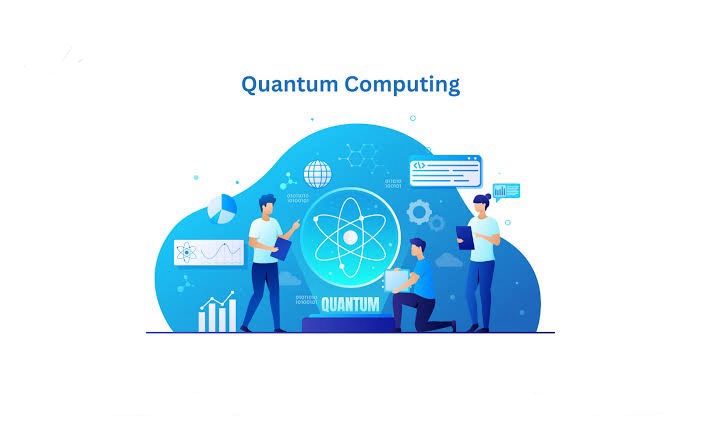
1. Introduction
Quantum computing stands at the forefront of a technological revolution, poised to redefine what is computationally possible. Unlike classical computers that process information in binary digits (bits) of 0s and 1s, quantum computers utilize quantum bits, or qubits, which can exist in multiple states simultaneously. This ability stems from principles of quantum mechanics, particularly superposition and entanglement, enabling quantum computers to solve problems exponentially faster than classical systems.
The concept of quantum computing has its roots in the 1980s, when physicists like Richard Feynman and David Deutsch theorized about using quantum systems for computation. Their work revealed that quantum computers could simulate physical systems that are intractable for classical machines. Over the decades, advancements in quantum mechanics, materials science, and computer science have brought this idea closer to reality. Today, quantum computing is no longer just theoretical it has become a practical field of research and development, attracting investments from governments, corporations, and academia.
The potential applications of quantum computing span a wide array of fields. In cryptography, quantum computers can break traditional encryption methods, necessitating the development of quantum-safe protocols. In medicine, they could revolutionize drug discovery by accurately simulating molecular interactions. Other domains, such as artificial intelligence, supply chain optimization, and climate modeling, also stand to benefit from quantum computing’s unparalleled computational power.
However, quantum computing is not without its challenges. The technology is still in its infancy, with issues like qubit stability (or decoherence), error correction, and scalability impeding the development of large-scale quantum systems. Moreover, the economic costs associated with building and maintaining quantum hardware are immense, requiring specialized facilities and highly skilled personnel.
Despite these hurdles, the race to achieve quantum supremacy—the point at which a quantum computer can solve a problem faster than the best classical supercomputer—has already begun. In 2019, Google claimed this milestone with its Sycamore processor, which performed a computation in 200 seconds that would have taken the most advanced classical supercomputer thousands of years. While this achievement was specific to a narrow problem, it marked a significant step toward realizing the broader potential of quantum computing.
This essay explores the transformative possibilities of quantum computing, breaking down its fundamental principles, potential applications, current challenges, and ethical implications. It also examines the industry landscape, highlighting key players and global initiatives driving the technology forward. Finally, the essay looks ahead to the future of quantum computing, considering the steps needed to integrate it into mainstream technology and address its societal impacts.
In a world increasingly reliant on data, quantum computing represents a paradigm shift, offering the ability to tackle problems that classical systems cannot. While its full realization may be years or decades away, its potential is already reshaping how we think about computation, innovation, and the future of technology.
2. Fundamentals of Quantum Computing
Quantum computing is built on the principles of quantum mechanics, a branch of physics that describes the behavior of matter and energy at the smallest scales. Unlike classical computing, which relies on bits that represent either a 0 or a 1, quantum computing uses qubits, which can exist as 0, 1, or both simultaneously through a property known as superposition. This fundamental difference gives quantum computers the ability to process vast amounts of information in parallel, making them exponentially more powerful for certain types of computations.
Key Principles of Quantum Mechanics in Computing
- Superposition:
Superposition allows qubits to exist in multiple states at once. For example, while a classical bit is like a coin showing either heads (0) or tails (1), a qubit is like a spinning coin that represents heads, tails, and all possible combinations of heads and tails. When scaled across multiple qubits, superposition enables quantum computers to explore a vast number of solutions simultaneously. This property is especially useful in solving optimization problems or simulating complex systems. - Entanglement:
Entanglement is a phenomenon where two or more qubitsbecome correlated in such a way that the state of one qubitdirectly influences the state of the others, regardless of distance. This interconnection enables quantum computers to process information in a highly coordinated manner, enhancing computational efficiency. For instance, entangled qubits can work together to solve complex algorithms that would take classical computers centuries to complete. - QuantumTunneling:
Quantum tunneling allows particles to pass through barriers that would be insurmountable in classical physics. In quantum computing, this property can be harnessed to find optimal solutions in problems with many possible states, such as determining the shortest path in a complex network.
Qubits vs. Classical Bits
Classical computers store and process information in binary form, using transistors that can be in one of two states: on (1) or off (0). Quantum computers, on the other hand, encode information in qubits, which can exist in multiple states simultaneously due to superposition. The power of quantum computers grows exponentially with the number of qubits, while classical computers experience only linear growth with added bits.
A single qubit can represent two states at once, two qubits can represent four states, and so on. With nnn qubits, a quantum computer can represent 2n2^n2n states simultaneously. For example, a 300-qubit quantum computer could represent more states than there are atoms in the observable universe, showcasing the staggering potential of quantum computation.
Quantum Gates and Algorithms
In classical computing, logic gates perform operations on bits. Quantum computers use quantum gates to manipulate qubits, changing their probabilities and states. Quantum gates operate within the framework of quantum mechanics, allowing for operations that have no classical equivalent.
Some groundbreaking quantum algorithms include:
- Shor’s Algorithm: Efficiently factors large numbers, threatening traditional encryption methods.
- Grover’s Algorithm: Speeds up search processes in unsorted datasets, providing a quadratic improvement over classical methods.
Quantum gates and algorithms exploit superposition and entanglement to perform tasks that classical computers find intractable, laying the foundation for revolutionary advancements in computation.
Hardware Implementation
Building a quantum computer requires sophisticated hardware. Qubits can be realized using various technologies, including superconducting circuits, trapped ions, and photons. Maintaining the delicate quantum state of qubits is one of the greatest challenges, as interactions with the environment cause decoherence, leading to loss of information. Advanced cooling systems, error-correction techniques, and isolation strategies are essential for sustaining quantum states.
In summary, the fundamentals of quantum computing rooted in quantum mechanics equip it with unprecedented computational capabilities. By leveraging superposition, entanglement, and quantum gates, quantum computers promise to redefine our approach to solving complex problems, albeit with significant technical hurdles still to overcome.
3. Potential Applications
Quantum computing is a transformative technology with the potential to revolutionize numerous industries. By harnessing the principles of superposition and entanglement, quantum computers can solve problems that are currently intractable for classical systems. From cryptography and healthcare to artificial intelligence and climate modeling, the range of applications is vast and continually expanding.
1. Cryptography
One of the most widely discussed applications of quantum computing is its impact on cryptography. Classical encryption methods, such as RSA and ECC (Elliptic Curve Cryptography), rely on the difficulty of factoring large numbers or solving discrete logarithmic problems. Quantum computers, equipped with Shor’s algorithm, can perform these tasks exponentially faster than classical systems, rendering traditional encryption methods obsolete.
This poses a significant threat to global cybersecurity. Financial institutions, government communications, and personal data protected by classical encryption could become vulnerable. In response, researchers are developing quantum-safe cryptography, which includes lattice-based encryption and code-based cryptography. These methods are resistant to quantum attacks, ensuring the security of sensitive information in a post-quantum world.
2. Drug Discovery and Healthcare
Quantum computing has immense potential in the field of healthcare, particularly in drug discovery. Simulating molecular interactions and quantum mechanical behavior of atoms is computationally intensive for classical computers. Quantum computers, however, excel at simulating quantum systems, enabling researchers to model complex molecules with high precision.
This capability can accelerate the development of new drugs and materials, reducing both cost and time. For example:
- Personalized Medicine: Quantum simulations can identify how individual genetic variations influence drug efficacy, paving the way for tailored treatments.
- Protein Folding: Predicting protein structures more accurately can lead to breakthroughs in treating diseases like Alzheimer’s and Parkinson’s.
3. Optimization Problems
Optimization problems, which involve finding the best solution among a vast set of possibilities, are ubiquitous across industries. Quantum computers, particularly through quantum annealing, are uniquely suited to solve these problems efficiently.
Applications include:
- Supply Chain Management: Optimizing routes and inventory allocation for logistics companies.
- Financial Modeling: Enhancing portfolio optimization, risk assessment, and fraud detection in the financial sector.
- Energy Distribution: Streamlining power grid operations to reduce energy loss and improve efficiency.
For instance, Volkswagen has used quantum computing to optimize traffic flow in urban environments, demonstrating real-world benefits in reducing congestion.
4. Artificial Intelligence and Machine Learning
Quantum computing has the potential to revolutionize artificial intelligence (AI) and machine learning (ML) by processing massive datasets more efficiently. Classical ML algorithms often face limitations in terms of computational speed and resource requirements. Quantum-enhanced algorithms, such as quantum support vector machines and quantum neural networks, can significantly accelerate training processes and improve model accuracy.
Specific applications include:
- Natural Language Processing: Faster and more accurate translation and sentiment analysis.
- Pattern Recognition: Enhanced capabilities in image and speech recognition.
- Data Clustering: Identifying patterns in large datasets for predictive analytics.
By integrating quantum computing, AI systems can become smarter and more efficient, unlocking new possibilities in automation and decision-making.
5. Climate Modeling and Materials Science
Quantum computing’s ability to model complex systems makes it invaluable for addressing global challenges like climate change. Climate models involve numerous variables, from atmospheric conditions to ocean currents, requiring immense computational power to simulate accurately. Quantum computers can improve the precision of these simulations, helping researchers understand and mitigate the effects of climate change.
In materials science, quantum simulations can predict the properties of new materials, leading to innovations in:
- Superconductors: For lossless energy transmission.
- Batteries: Developing high-capacity, efficient energy storage systems.
- Renewable Energy: Enhancing solar cells and wind turbine designs.
6. Scientific Research
Beyond specific industries, quantum computing holds promise for advancing scientific research in areas like particle physics, cosmology, and quantum chemistry. For example:
- Particle Physics: Simulating subatomic particles to test theories of the universe.
- Cosmology: Modeling the early universe and solving equations related to dark matter and dark energy.
- Quantum Chemistry: Exploring chemical reactions at a fundamental level, leading to breakthroughs in green energy and manufacturing.
Quantum computing’s transformative applications illustrate its vast potential to address humanity’s most complex challenges. While practical implementations are still in early stages, the progress in research and development indicates that these applications will become increasingly accessible in the near future. Industries that invest in quantum technologies now will be better positioned to harness its power, driving innovation and solving critical global problems.
4. Current Challenges
Despite the immense potential of quantum computing, the technology is still in its infancy and faces several significant challenges. These hurdles are not only technical but also economic and practical, delaying its widespread adoption. Understanding these challenges is crucial to addressing the barriers to realizing quantum computing’s full potential.
1. Hardware Limitations
One of the biggest challenges in quantum computing is the fragility of qubits. Unlike classical bits, qubits rely on delicate quantum states that are easily disturbed by external factors like temperature, electromagnetic fields, and vibrations. This phenomenon, known as decoherence, causes qubits to lose their quantum properties, leading to errors in computation.
To minimize decoherence, quantum computers must operate in highly controlled environments, often at temperatures near absolute zero. For example,superconducting qubits require cryogenic cooling systems, making quantum computers expensive to build and maintain.
Another issue is scalability. Current quantum processors have limited numbers of qubits most practical systems operate with fewer than 1,000 qubits, whereas millions may be needed for fault-tolerant, general-purpose quantum computing. Moreover, as more qubits are added, the complexity of controlling and entangling them grows exponentially.
2. Error Rates and Quantum Error Correction
Quantum computers are inherently error-prone due to the instability of qubits and the probabilistic nature of quantum mechanics. Unlike classical computers, which can perform calculations with near-perfect reliability, quantum systems require sophisticated error-correction mechanisms to ensure accuracy.
Quantum error correction involves adding redundant qubits to detect and correct errors in real time. For example, a single logical qubit may require dozens or even hundreds of physical qubits to achieve fault tolerance. This overhead significantly increases the hardware requirements and computational complexity. Developing efficient error-correction methods remains an active area of research.
3. Economic Costs
Building and maintaining quantum computers is extremely expensive. The infrastructure needed, including cryogenic cooling systems, precision engineering, and shielding from environmental noise, represents a significant financial barrier. Only well-funded organizations, such as governments, large corporations, and elite academic institutions, can afford to invest in quantum computing research and development.
Additionally, quantum computing is not yet at a stage where it can consistently deliver a return on investment. Many businesses are hesitant to adopt the technology until it demonstrates clear, practical benefits over classical systems.
4. Workforce and Expertise Gap
Quantum computing is a multidisciplinary field requiring expertise in physics, mathematics, computer science, and engineering. However, there is a shortage of professionals with the skills needed to develop and implement quantum technologies.
This skills gap extends beyond researchers to include engineers, software developers, and business leaders who can integrate quantum computing into practical applications. Educational institutions are working to address this issue by offering specialized programs and courses, but building a qualified workforce will take time.
5. Compatibility with Existing Systems
Quantum computers are not designed to replace classical computers but to complement them by solving specific types of problems. However, integrating quantum systems with existing classical infrastructure presents technical and logistical challenges. For instance, data must be transferred between classical and quantum systems efficiently, which is not yet fully optimized.
Additionally, developing software for quantum computers requires specialized programming frameworks, such as IBM’s Qiskit or Google’s Cirq. These tools are still evolving, and many developers are unfamiliar with quantum programming paradigms, further slowing adoption.
6. Technological and Scientific Uncertainty
The field of quantum computing is still exploratory, and there is no consensus on the best approach to building quantum systems. Competing technologies, such as superconducting qubits, trapped ions, and photonic qubits, each have their own advantages and limitations. This uncertainty complicates investment decisions and slows progress toward a unified standard.
Moreover, fundamental scientific questions about quantum mechanics and computation remain unanswered. For example, achieving scalable, error-free quantum computing may require breakthroughs in materials science, algorithms, or entirely new paradigms of quantum architecture.
7. Public and Policy Challenges
Quantum computing also faces societal and regulatory challenges. The technology has the potential to disrupt industries and economies, raising questions about equitable access and ethical use. Governments must develop policies to promote quantum research while mitigating risks, such as the misuse of quantum technologies for cybersecurity breaches.
Conclusion
The challenges facing quantum computing are daunting but not insurmountable. Ongoing research and collaboration among scientists, engineers, and policymakers are driving progress in areas such as error correction, scalability, and workforce development. While quantum computing is not yet ready for widespread adoption, overcoming these challenges will pave the way for its transformative potential to be fully realized.
5. Vision for the Future
The ultimate vision for quantum computing is a world where its transformative power drives innovation and addresses global challenges. By enabling breakthroughs in medicine, energy, climate science, and beyond, quantum computing has the potential to significantly improve quality of life and promote sustainable development.
At the same time, its future success depends on a delicate balance between technological progress, ethical responsibility, and equitable access. The decisions made today will shape the trajectory of quantum computing, determining whether it becomes a force for good or a source of unforeseen challenges.
Read also: Beyond the Blue Marble, Chronicles of the Orbital Elite
Conclusion
Quantum computing is a game-changing technology that promises to revolutionize multiple fields, from medicine to finance to artificial intelligence. However, significant challenges remain in terms of hardware, scalability, error correction, and security. The industry is evolving rapidly, with major players from tech companies, governments, and academia pushing the boundaries of what is possible. Addressing the ethical, security, and regulatory implications of quantum computing will be crucial to ensuring that this powerful technology benefits society as a whole. The next few decades will be pivotal in determining how quantum computing transforms our world.
Buy Now
Quantum Computing for Computer Scientists

